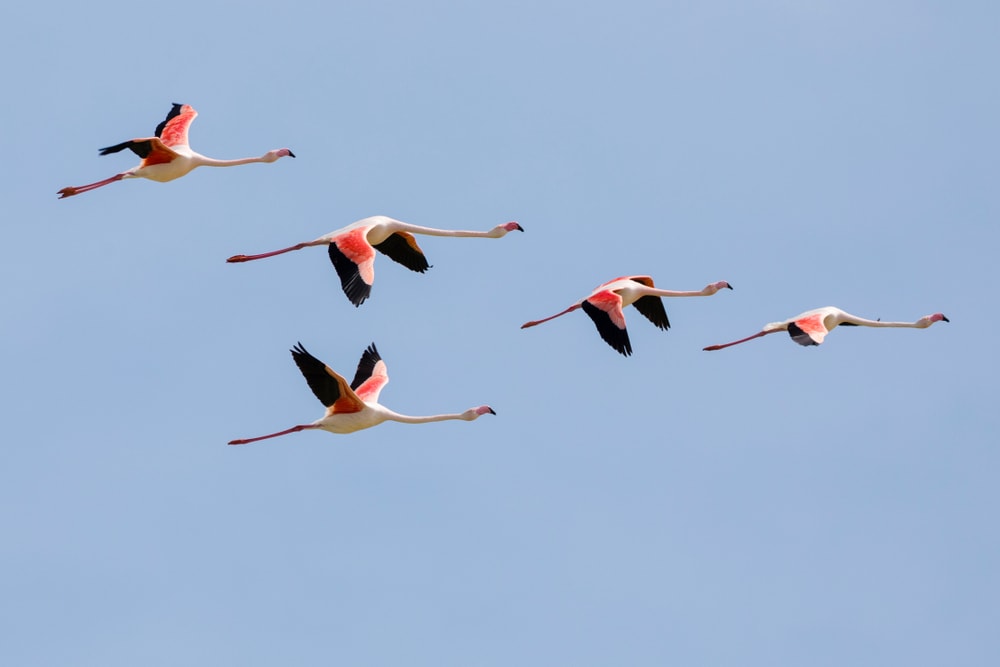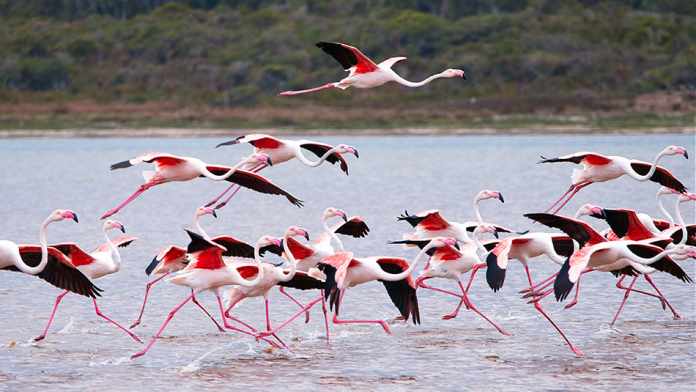What is Flamingos?|Can Flamingos Fly? The flamingo is a captivating and elegant bird that is known for its vibrant plumage and unique behavior. This captivating creature is often questioned about its ability to fly. Throughout this article, we will explore the anatomy and flight abilities of flamingos to determine whether their renowned beauty is confined to their ground-based activities or if they are capable of taking to the skies.
Table of Contents
What is Flamingos?
The flamingo is a large wading bird that is distinguished by its unique appearance and behavior. These birds are members of the Phoenicopteridae family and are known for their long legs, curved necks, and vibrant plumage. The flamingo is found throughout the world, including Africa, Asia, South America, and Europe.
Anatomy and Physical Characteristics of Flamingos
1. Unique Features
Flamingos are distinguished from other bird species by several distinctive characteristics. A few examples of these characteristics include their long legs, flexible necks, and highly specialized bills. The adaptations they have developed are perfectly suited to their preferred habitats, which primarily consist of shallow lakes, lagoons, and mudflats.
2. Wing Structure
One of the most important features of the flamingo’s anatomy is its wings. It is important to note that although they appear large and broad, they are proportionately smaller in body size when compared to other flying bird species. The reason for the relatively smaller wing size of these birds is their natural surroundings which require them to have specific requirements.
3. Adaptations for Flight
The flamingo spends much of its time wading in the water and foraging for food; however, because of their adaptations, they can take flight when necessary. A bird’s flight feathers, which are responsible for providing lift and maneuverability, are situated on the outward-facing portions of its wings. They can harness the air currents effectively thanks to this feather distribution.
Flight Abilities of Flamingos
1. Takeoff and Landing
When flamingos prepare to take flight, they typically run across the surface of the water, thereby creating the lift they need to take flight. As a result, this takeoff technique is known as a “running takeoff,” and is quite different from that of some other species of birds, which take off by leaping vertically. The flamingo also descends gracefully when landing, skillfully maneuvering its body into precise positions before touching down.
2. Flying Speed and Distance
The flamingo is not known for its fast flight speed, however, it is capable of covering a considerable distance during migration. During these long-distance flights, they can access suitable habitats and food sources. Despite their slower flight speed than that of smaller birds, flamingos compensate for this with their endurance and ability to fly for a prolonged period.

3. Flight Patterns
It is common for flamingos to form large linear or V-shaped formations when in flight. Additionally, this arrangement serves a functional purpose in addition to being visually appealing. Their formation enables them to reduce wind resistance, conserve energy, and maintain a sense of community. As a result of their flocking behavior, they can optimize their overall flight efficiency and safety during migration.
Factors Affecting Flamingos’ Flying Abilities
1. Body Size and Weight
A flamingo’s body size and weight are two factors that influence its flight capabilities. There are relatively large birds of this species, whose bodies are adapted to wading and standing in water. It is important to note that, while their size does not prevent them from flying, it does limit their agility and speed when flying.
2. Wing Shape and Musculature
The shape of a bird’s wings directly affects its ability to fly. Rather than flapping their wings rapidly, flamingos have long, slender wings that enable them to glide and sustain their flight. They maintain stability and maneuverability while in flight because their wings have a specialized musculature designed to support their gliding movements.
3. Environmental Factors
Flamingos’ flying abilities are significantly influenced by environmental factors. Several factors can affect the flight performance of these aircraft, including wind speed, direction, and turbulence. In calm weather conditions with little wind, flamingos are more likely to take flight, since excessive winds can make flying difficult.
Flamingos’ Preference for Wading and Standing
Despite their ability to fly, flamingos usually prefer to wade in shallow water and stand while wading. Their behavior is a result of their feeding habits, as they are primarily attracted to algae, small invertebrates, and other aquatic organisms that can be found in water bodies. Foraging in the water is made easier by their long legs and specialized beaks, which enable them to filter out food particles efficiently.
Conclusion
There is no doubt that flamingos can fly. While their flight abilities may not be as acrobatic or swift as those of smaller bird species, they have evolved adaptations that allow them to take flight and cover long distances during migration. Their special feather distribution, unique wing structure, and endurance make them capable of flight. As a result of their larger bodies and specialized adaptations for wading and standing, flamingos tend to prefer these activities to sustained flight.
















